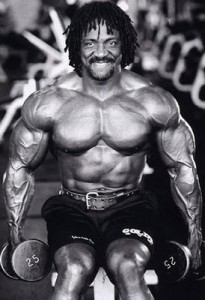 The Bodybuilding Wizard
The Bodybuilding Wizard
I wanted to ask you what your take on superset training was. I have recently gone from having my program done for me by a personal trainer, to building my programs myself. Not being a fitness professional, I am learning all the tricks, rules and combos myself. Having a 9-to-5 job, I like super-setting, because I can get a full workout in under an hour. Do you use supersets in your training, and if so, care to share some of your favorite combos— if that is not giving away trade secrets?
I don’t have a whole lot of trade secrets. People see me training clients every day at Gold’s, so any secrets I had would be passed along pretty fast these days— probably via someone’s cell phone video!
I use various supersets with clients close to a contest. I feel they are a great way to carve a bit more detail and separation into the muscles. But I don’t feel that using them abundantly would be a smart idea for anyone hoping to build size.
As you know, supersets are defined as performing sets of two different exercises, back to back with no rest in between. Typically, they involve two exercises for the same muscle group, such as barbell curls and preacher curls for biceps, or squats and walking lunges for quads (that one is not for the weak of heart). At other times, supersets are done with exercises for opposing muscle groups, like back and chest, or biceps and triceps.
A lot of bodybuilders like to do these for arms, as it allows the entire upper arm to hold a pump throughout the workout, rather than just the bi’s or tri’s. A final type of superset is the pre-exhaust superset, which has you performing an isolation movement for a muscle group immediately followed by a compound exercise. Examples would include leg extensions and leg presses for quads, pec deck and bench press for chest, or lateral raises and overhead presses for shoulders.
Used occasionally, all these types of supersets can be effective at boosting intensity. But if you use them too often, you risk overtraining. Another thing I don’t like about doing a lot of supersets in the off-season is that they limit the amount of weight you can handle. Though it’s not as severe with opposing muscle groups, supersets involving two movements for the same muscle group invariably means that you are forced to use less weight on the second exercise in the cycle. Heavy straight sets, as basic and boring as they may seem to some bodybuilders, are still the absolute best way to build mass.
As for your time issue, you should be able to work a body part in just under an hour, as long as you move fairly quickly and don’t waste time. Wear headphones if you tend to get caught up talking and socializing. Instead of making constant trips to the water fountain, carry a water bottle with you. Large body parts like back and legs can get a great workout with 3-4 work sets of 4-5 exercises. There’s no reason you can’t do that in an hour. As for smaller muscle groups, those shouldn’t take you more than 30 minutes.
I have recently read Mike Mentzer’s book on heavy duty training and am considering implementing it. Just wondering if you have tried it and/or do it, and your thoughts on it. Also, you were a trainer at Gold’s Gym in Venice at the same time as Mr. Mentzer. Did you know him very well?
Yes, I would say I knew Mike pretty well. And as far as heavy duty training as it applied to his clients, I have to say that I never saw any of his clients appear to make any substantial gains. I don’t mean to speak ill of the dead of disparage his theories, but I simply never felt and still don’t believe that such brief workouts provide sufficient stimulation to bring about muscle growth.
He was a big believer in the superiority of machines, but to this day, I have yet to meet a single person who had built an exceptional physique using only machines. Barbells may be ‘old-fashioned,’ but they will never become obsolete as tools for building muscle— they just work too darn well!
Another issue I had watching Mike train clients was that he often had them going extremely heavy on movements like squats, but not even going halfway down. I have always believed that a full range of motion is the best route to train a muscle effectively. I recall speaking with one of his former clients, who casually mentioned that he could squat 600 pounds. Sure he could— dipping down about six inches. When it came to full range, he couldn’t even do a single full rep with 405— and his legs certainly didn’t look like anything special.
The final issue I had with Mentzer’s teachings was that he didn’t put much value on nutrition. He had some mathematical formula he had come up with that claimed you only needed a very small amount of extra calories a day to fuel muscle growth; I’ve found that when most bodybuilders aren’t gaining, they usually aren’t eating enough.
I don’t say this to either brag or to further put down Mike’s theories, but I picked up a couple of his clients after he passed away. Each one got bigger and leaner in a matter of weeks. Mike Mentzer was one of the best bodybuilders of his era and he was a brilliant man, but I think he was somewhat misguided in some of his theories.
My work schedule is really killing me. I work 7 a.m.-7 p.m. Monday, Wednesday, Thursday, and Friday as a paramedic on an ambulance. That gives me three days off. Most nights I don’t get off until 7:30 or 8, sometimes even later. If you get a call, you gotta go even if it’s 5 minutes before the end of your shift.
My workouts have been suffering and I’m considering just trying to train everything on my days off, being Saturday, Sunday, and Tuesday. On Saturday, I was thinking of doing chest, front and side delts, and tri’s. Sunday would be back, traps, rear delts and bi’s. On Tuesday, I would work legs and abs. Do you think this is too much and will only set me back more, or what? Thanks, man.
If I was in your situation, I would train only on those days, but I would do double splits. In other words, here’s how I would arrange it:
a.m. p.m.
Saturday Chest Shoulders and triceps
Sunday Back Traps, rear delts, and biceps
Tuesday Quads Hams and abs
You could try to do those workouts all in one session, but splitting them up would allow you to devote so much more energy into them. Legs can be done all at once, but attempting to work all the pushing or all the pulling muscles of the upper body in a single workout is asking a bit much of your body and your nervous system. You’ll no doubt do the best on the first muscle group you train, and if you’re honest and objective with yourself, you will find that you don’t do much justice, comparatively speaking, to the remaining areas.
Training on those days and then going the next three days in a row with no training at all could cause you to lose a bit of size, so you might want to consider keeping a pair of dumbbells in the ambulance with you, if that’s possible, to use on your downtime. Even without a bench, there are plenty of exercises you could do just using dumbbells: rows, overhead presses, lateral raises, curls, squats, lunges, kickbacks, and overhead extensions. Even a set here and there when you have a bit of downtime would be adequate to preserve your muscle size and strength pretty well. Good luck, and keep doing that important job out there on the streets!
source:musculardevelopment.com
